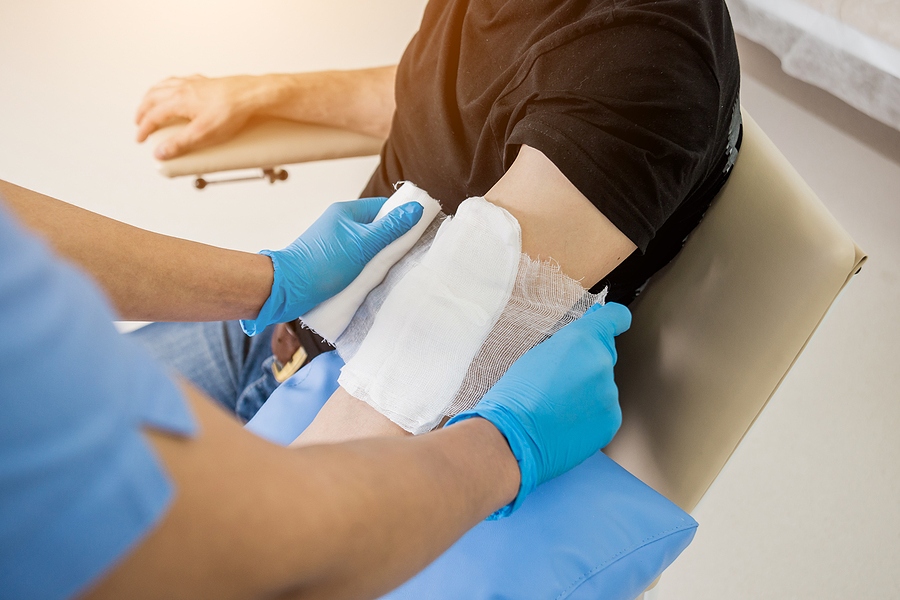
Burn injuries can be severe and life-threatening. Burns damage the skin and the nerves underneath, sometimes requiring surgery and skin grafts to help the wound heal. Burn treatment can be expensive and painful. It may also leave you with lifelong scars, disfigurement, or deformity.
If you or someone you love has been injured in a burn accident, you may be entitled to compensation for any damages associated with your injuries. Please read on and contact our talented attorneys here at The Eberst Law Firm for more information on how to file a lawsuit against the at-fault party.
Burns classified by degree
The severity of a burn is classified on a degree scale, with a first-degree burn being the least serious and a fourth-degree burn is the most serious. The degree scale covers fire burns, electrical burns, and chemical burns.
A first-degree burn or superficial burn only affects the outer layer of skin (the epidermis). These burns are painful, causing the site of the burn to become red and dry. There are no blisters present with first-degree burns.
A second-degree burn or partial thickness burn affects the first layer of skin and the lower layer of skin (the dermis). Second-degree burns are often swollen and painful with blisters.
A third-degree burn or full-thickness burn fully destroys the epidermis and the dermis and may cause further damage to the lowest layer of skin as well as the tissue below. These burns can look white, blackened, or charred and are extremely painful.
A fourth-degree burn damages all layers of skin as well as the tissue below. Fourth-degree burns can also damage muscle and bone. There won’t be any feeling in the area as fourth-degree burns will destroy the nerve endings.
Common causes of burns
Burn injuries can occur for various reasons because of various accidents. According to the American Burn Association (ABA), approximately 500,000 burn injuries are treated annually. Common causes of burn injuries include:
- Contact with a fire or flame
- Scalding injuries from steam or hot liquids
- Electrical burns
- Chemical burns
- Car fires
Electrical burns can occur when coming into contact with loose wires or working on electricity unsafely or without ensuring the electricity has been turned off first. If an electrical burn occurs at your workplace, your employer could be liable for not providing proper safety training or if another party didn’t ensure that the electricity was turned off before you started working.
Chemical burns can occur if you come in contact with unsafe chemicals without the proper defense. Your employer might be liable if you weren’t trained properly on how to handle these chemicals. Chemical burns can also occur outside of the workplace.
How are burns treated?
The treatment you receive for your burn injury depends on what level of burn you have, as a first-degree burn will receive drastically different treatment than a fourth-degree burn would. Most burns require medical care, so don’t hesitate to receive medical attention after your burns occur.
For lower-level burns like first and second-degree burns, the burn will be cooled by applying a cold compress or immersing it into cold freshwater. It will then be covered in sterile gauze and bandaged. If there are blisters present, do not pop or break the blisters.
For third-degree burns and higher, treatment includes cleaning the burn and laying flat to prevent going into shock. Treatment will likely require surgery and a skin graft. Even with proper treatment, you may be left with scarring and disfigurement. Plastic surgery is an option in some cases.
Safety tips for burn prevention
Following safety tips is the best way to prevent burns from occurring. If you work in a place where burns are possible, it’s your workplace’s job to ensure that you’re equipped with the proper safety training.
To prevent burns, follow these crucial safety tips:
- Unplug or turn off any electricity before working on electrical components.
- Lock up all matches and lighters to prevent children from gaining access to them.
- Don’t keep ovens on, candles burning, or fireplaces going when you’re not around to supervise them.
- Install a smoke detector and make sure it’s always in working order.
- Follow all safety guidelines regarding burn prevention posted at your workplace.
Damages that can be claimed in a burn injury lawsuit
If you have been injured because of someone else’s negligence, you may be entitled to compensation for your damages. You can claim both economic and non-economic damages. Economic damages cover your lost wages, medical bills, and other monetary losses you may have experienced. Non-economic damages cover pain and suffering, loss of earning capacity, and any compensation for disfigurement or scarring.
You may also receive compensation for punitive damages. Punitive damages are used to punish the at-fault party for their actions further. They may be used to prevent the same party (or similar parties) from committing the same act again in the future.
Hire a Personal Injury Law Firm to Represent your injury claim
If you or someone you love has been injured because of a burn accident, please contact our talented attorneys here at The Eberst Law Firm to discuss your potential lawsuit. Our team of attorneys has years of experience working on burn cases, and we’re ready to take on yours.
For more information or a free case evaluation, please contact us online using our chat box option or by calling us at 772-225-4900.
